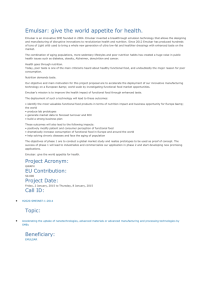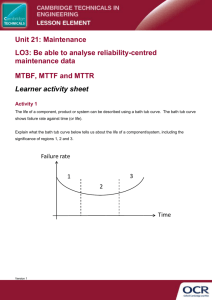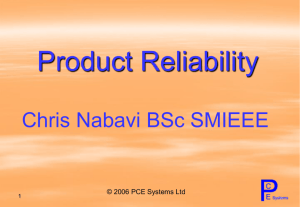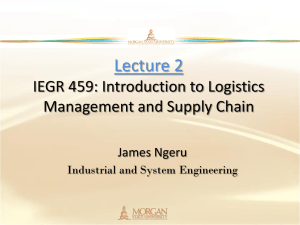26 Jun Slides - Supply Chain Research Institute
advertisement
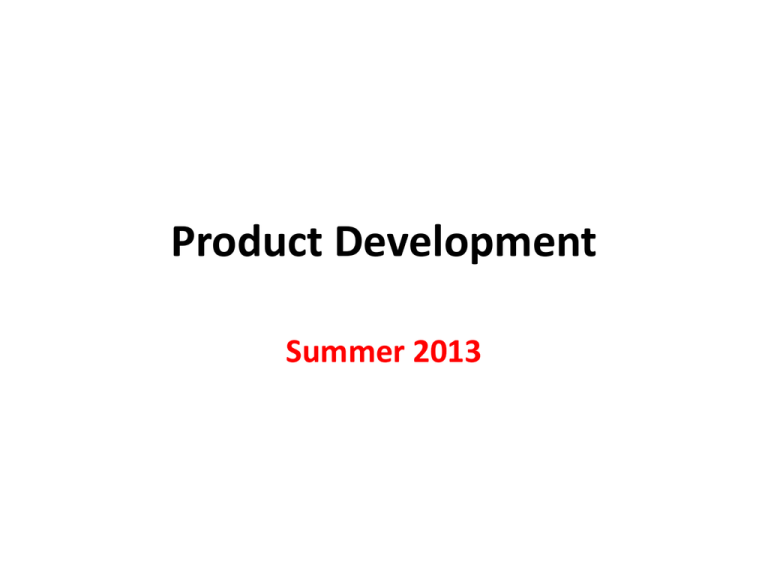
Product Development Summer 2013 Increasing Importance of Product Development 1. Customers demand greater product variety. 2. Customers are causing shorter product life cycles. 3. Improving technology is causing new products to be introduced 4. The impact of increasing product variety and shortening product life cycles is having a multiplicative effect on the need for product development. 5. Today, in order to be competitive, the firm may have to produce many different products with a life cycle of only five years or less. End of Life issues Product Design Specifies materials Determines dimensions & tolerances Defines appearance Sets performance standards Service Design Specifies what the customer is to experience Physical items Sensual benefits Psychological benefits An Effective Design Process Matches product/service characteristics with customer needs Meets customer requirements in simplest, most cost-effective manner Reduces time to market - haste vs. speed to market Minimizes revisions - quality designed into the product Stages in the Design Process Idea Generation — Product Concept - can you create your own market? What role does the voice of the customer play in idea generation? Feasibility Study — Performance Specifications Preliminary Design — Prototype - testing and redesign Final Design — Final Design Specifications Process Planning — Manufacturing Specifications - make to order/stock – assembly line? Idea Generation Suppliers, distributors, salespersons Trade journals and other published material Warranty claims, customer complaints, failures Customer surveys, focus groups, interviews Field testing, trial users Research and development More Idea Generators Perceptual Maps Visual comparison of customer perceptions Benchmarking Comparing product/service against best-in-class Reverse engineering Dismantling competitor’s product to improve your own product Perceptual Map of Breakfast Cereals GOOD TASTE LOW NUTRITION HIGH NUTRITION BAD TASTE Perceptual Map of Breakfast Cereals GOOD TASTE Cocoa Puffs LOW NUTRITION HIGH NUTRITION Rice Krispies Cheerios Wheaties Shredded Wheat BAD TASTE © Russell and Taylor, Prentice Hall, 2004 Perceptual Map of Breakfast Cereals GOOD TASTE How do I get here? Cocoa Puffs LOW NUTRITION HIGH NUTRITION Rice Krispies Cheerios Wheaties Shredded Wheat BAD TASTE © Russell and Taylor, Prentice Hall, 2004 Feasibility Study Market Analysis Market Segmentation Economic Analysis Technical / Strategic Analysis Performance Specifications Risk Analysis Economic Analysis • Can we produce it at a volume to make a profit? • If not, why produce? • How many do we have to make to break even? Break Even Analysis Total Costs = Total Revenues (Volume x Price) = (Fixed Costs + Variable Costs) Profit = (Total Revenue – Total Costs) Fixed Costs B/E Point = Sales Price – Variable Costs Example Fixed Costs = $2000 Variable Costs = $5/item Sales Price = $10/item Fixed Costs ($2000) B/E PT = Sales Price ($10) – Variable Costs ($5) B/E point = ($2000/$5) 400 items Risk Analysis 1. Identify the Hazards 2.Assess hazards to determine risks. 3.Develop controls and make risk decisions. 4.Implement controls. 5.Supervise and evaluate. Preliminary Design How will it look? Create form & functional design Build prototype Test prototype Revise prototype Retest Functional Design (How the Product Performs) Reliability Probability product performs intended function for specified length of time Maintainability Ease and/or cost or maintaining/repairing product System Availability System Availability, SA = MTBF MTBF + MTTR PROVIDER MTBF (HR) MTTR (HR) A B C 60 36 24 4.0 2.0 1.0 System Availability PROVIDER MTBF (HR) MTTR (HR) A B C 60 36 24 4.0 2.0 1.0 SAA = 60 / (60 + 4) = .9375 or 93.75% SAB = 36 / (36 + 2) = .9473 or 94.73% SAC = 24 / (24 + 1) = .96 or 96% Production Design Part of the preliminary design phase Simplification Standardization Modularity Final Design & Process Plans Produce detailed drawings & specifications Create workable instructions for manufacture Select tooling & equipment Prepare job descriptions Determine operation & assembly order Program automated machines Improving the Design Process Design teams Concurrent design Design for manufacture & assembly Design to prevent failures and ensure value Design for environment Measure design quality Utilize quality function deployment Design for robustness Engage in collaborative design Design Teams Preferred solution = cross functional teams Marketing, manufacturing, engineering Suppliers, dealers, customers Lawyers, accountants, insurance companies Concurrent Design Improves quality of early design decisions Decentralized - suppliers complete detailed design Incorporates production process Scheduling and management can be complex as tasks are done in parallel include the customer in the process!! Design for Manufacture and Assembly Design a product for easy & economical production Incorporate production design early in the design phase Improves quality and reduces costs Shortens time to design and manufacture also known as Design for Six Sigma Design for Six Sigma • Define – the goals of the design activity • Measure – customer input to determine what is critical to quality from the customers’ perspective – what are customer delighters? What aspects are critical to quality? • Analyze – innovative concepts for products and services to create value for the customer • Design – new processes, products, and services to deliver customer value • Verify – new systems perform as expected DFM Guidelines 1. Minimize the number of parts, tools, fasteners, and assemblies 2. Use standard parts and repeatable processes 3. Modular design 4. Design for ease of assembly, minimal handling 5. Allow for efficient testing and parts replacement Design for Assembly (DFA) Procedure for reducing number of parts Evaluate methods for assembly Determine assembly sequence Design Review Failure Mode and Effects Analysis (FMEA) A systematic approach for analyzing causes & effects of failures Prioritizes failures Attempts to eliminate causes Value Analysis (Value Engineering) Is there value added? Ratio of value / cost Assessment of value : 1. Can we do without it? 2. Does it do more than is required? 3. Does it cost more than it is worth? 4. Can something else do a better job 5. Can it be made by less costly method, tools, material? 6. Can it be made cheaper, better or faster by someone else? Should we contract it out? Design for Environment Design from recycled material Use materials which can be recycled Design for ease of repair Minimize packaging Minimize material & energy used during manufacture, consumption & disposal green laws in Europe - Design for Robustness Product can fail due to poor design quality Products subjected to many conditions Robust design studies Controllable factors - under designer’s control Uncontrollable factors - from user or environment Designs products for consistent performance A Well-Designed Service System is Consistent with firm’s strategic focus Customer friendly Easy to sustain Effectively linked between front & back office Cost effective Visible to customer Process Design Process Selection affects the outcome – in production or sports: 35 What is Process Selection? • Series of decisions that includes technical/engineering issues and volume/scale issues • Technical/engineering: basic methods that produce a good or service • Scale: how many or how much to produce; how many to serve at a time • Trade off analysis between capacity and costs 36 Why process selection is critical • Dell – from make/assemble to order in Texas to make/assemble to stock off shore • Does this work? • Break even analysis may depend on process costs • Which process gives the lowest costs – assumption? 37 Trade off analysis • Customer demanded quantity drives the trade off analysis and decision process • Example: → retail stocks at Christmas 2008 and 2009 season - goal save money by stocking less → At what point do you lose sales due to lower stockage levels? 38 Process Design/Selection/Capacity • Have to be simultaneous operations – some texts suggest sequential steps • Decision process has to be customer based → what should it be? → how many should be produced/how many are we capable of producing? → how should it be produced? 39 Process Strategy - Defines • • • • Capital intensity Process flexibility Vertical integration Customer involvement 40 Goal of Process Design • Reduce lead time for product to the customer • Is it best to be the first to market and establish the market? • Or, be the follower and let someone else do the R&D/design/risk? 41 Process Planning Make-or-buy decisions Process selection Specific equipment selection Process plans Process analysis 42 Make-or-Buy Decisions 1. 2. 3. 4. 5. 6. Cost Capacity Quality Speed Reliability Expertise What about Proprietary Information? Barrier to Make-or-Buy? 43 Process Plans Blueprints Bill of material Flat or multiple layers part or assembly Assembly chart / product structure diagram Operations process chart - list of operations involved in assembly Routing sheet - sequence of events 44 Process Analysis The systematic examination of all aspects of a process to improve its operation Faster More efficient Less costly More responsive Basic tools Process flowchart Process diagrams Process maps 45 Operations Process Chart Part name Crevice Tool Part No. 52074 Usage Hand-Vac Assembly No. 520 Oper. No. Description Dept. Machine/Tools Time 10 Pour in plastic bits 041 Injection molding 2 min 20 Insert mold 041 #076 2 min 30 Check settings & start machine 041 113, 67, 650 20 min 40 Collect parts & lay flat 051 Plastics finishing 10 min 50 Remove & clean mold 042 Parts washer 15 min 60 Break off rough edges 051 Plastics finishing 10 min 46 Process Analysis – What processes feed other processes? 47 Process Flowchart Description of process 1 Unload apples from truck 2 Move to inspection station 3 Weigh, inspect, sort 4 Move to storage 5 Wait until needed 6 Move to peeler 7 Apples peeled and cored 15 8 Soak in water until needed 20 9 Place in conveyor 5 10 Move to mixing area 11 Weigh, inspect, sort Page 1 0f 3 Total Distance (feet) Location: Graves Mountain Process: Apple Sauce Time (min) Operation Transport Inspect Delay Storage Step Date: 9-30-02 Analyst: TLR 20 100 ft 30 50 ft 360 20 ft 20 ft 30 480 190 ft 48 Principles for Redesigning Processes • • • • • Walk the Process! Remove waste, simplify, consolidate Link processes to create value Let the swiftest and most capable execute Capture information digitally, data mine, and use information to improve operations 49 Principles for Redesigning Processes • • • • • Provide visibility through information about process status Fit the process with sensors and feedback loops Add analytic capabilities Connect, collect and create knowledge around the process Personalize the process 50 Techniques for Generating Innovative Ideas Vary entry point to a problem Draw analogies Change your perspective Use attribute brainstorming 51 RFID • • • • Active Tags Always on Battery powered Can be read from up to 300 ft • US Army • Savi Tags • • • • • • • Passive Tags Small Must be activated May be turned off England California Rolex 52 Robotics Programmable manipulators Follow specified path Better than humans with respect to Hostile environments Long hours Consistency Adoption has been slowed by ineffective integration and adaptation of systems Welding at Harley Davidson Plant Questions? 53
